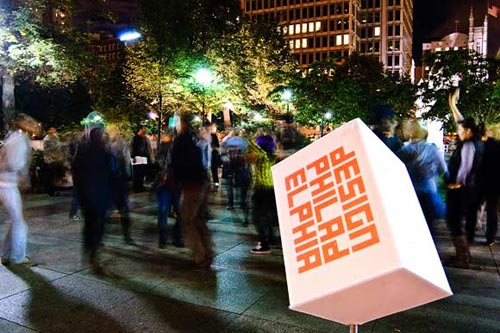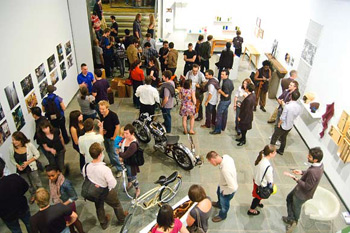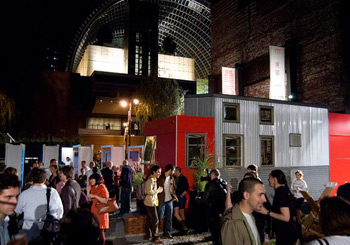 During four months in 2009, self-described cultural nomad Jay Corless and his partner in design, Sali Sasaki, set off on a “Cities x Design” tour. They visited 30 cities around America to gauge design cred and interview the players in each emerging creative economy. The duo skipped established urban centers like New York and Los Angeles in favor of underdogs like Omaha, Detroit, and Philadelphia. These are cities where brush fires of creativity have grown large enough to attract the notice of passersby. Corless and Sasaki set out to deconstruct that phenomenon and to discover how these cities go about kindling their creative capital.
During four months in 2009, self-described cultural nomad Jay Corless and his partner in design, Sali Sasaki, set off on a “Cities x Design” tour. They visited 30 cities around America to gauge design cred and interview the players in each emerging creative economy. The duo skipped established urban centers like New York and Los Angeles in favor of underdogs like Omaha, Detroit, and Philadelphia. These are cities where brush fires of creativity have grown large enough to attract the notice of passersby. Corless and Sasaki set out to deconstruct that phenomenon and to discover how these cities go about kindling their creative capital.
Corless and Sasaki allotted 2 to 3 days for each stop, but after spending some time in Philadelphia, they skipped their next city altogether to stay an extra day. “One thing that struck us,” says Corless, “was the link between heritage and moving forward. Philadelphia has this heritage as the world’s workshop. It’s really important that cities build from their inherent culture, and Philadelphia is doing so.”
 They were also impressed by what many visitors note about the city: its small scale, walkability, and the breadth of independent cafes and shops that give each neighborhood a unique identity. But the clincher was DesignPhiladelphia, the annual festival meant to celebrate and promote the design community. “To put that together shows an awareness that all of this exists and needs to be celebrated,” says Corless. Because of DesignPhiladelphia, which runs this year from October 7-17, he and Sasaki ranked Philadelphia in their top ten. They also featured DesignPhiladelphia in a film about their odyssey called “Old and New” that premiered in September at the Better City and Better Life Conference in Shanghai.
They were also impressed by what many visitors note about the city: its small scale, walkability, and the breadth of independent cafes and shops that give each neighborhood a unique identity. But the clincher was DesignPhiladelphia, the annual festival meant to celebrate and promote the design community. “To put that together shows an awareness that all of this exists and needs to be celebrated,” says Corless. Because of DesignPhiladelphia, which runs this year from October 7-17, he and Sasaki ranked Philadelphia in their top ten. They also featured DesignPhiladelphia in a film about their odyssey called “Old and New” that premiered in September at the Better City and Better Life Conference in Shanghai.
Corless and Sasaki aren’t the only ones impressed by DesignPhiladelphia, which has grown to be the largest open-source design event of its kind in the country. People in Seattle and Boston who are interested in duplicating similar events in their cities have called asking for a template. A presentation on DesignPhiladelphia will be part of an AIGA (the national professional association for design) conference later this year.
The festival is unique from other design events in the country, which occur around industry happenings. New York’s Design Week, for instance, is the same week as ICFF (International Contemporary Furniture Fair), the giant, international annual design trade show. DesignPhiladelphia comes from a more organic place — from the mind of Executive Director and founder, Hilary Jay, who was Director of the Design Center at Philadelphia University when she identified the need for an exhibition and symposium to bring together the city’s seven schools with design programs. She’d long been brainstorming with friends and colleagues in the local design universe about how to nurture and showcase Philadelphia’s copious raw materials.
 “We’re not the sixth borough,” says Jay, who hails originally from Baltimore but has lived in Philadelphia since graduating from the University of Pennsylvania in 1985. “Philadelphia is a different place altogether. We have our own unique qualities and talents. We’re having our own conversation about design.” She and her collaborators fashioned the festival, which was largely focused on students at the beginning, after London’s. To prevent competition, each school took on a different slice of design. The first year saw 50 events; in the second year, retailers and galleries opened their doors for special events. In 2008, the festival grew to 93 events and its profile changed to an open-source promotion machine for galleries, retailers, and design and architecture firms; the universities presented parallel programs.
“We’re not the sixth borough,” says Jay, who hails originally from Baltimore but has lived in Philadelphia since graduating from the University of Pennsylvania in 1985. “Philadelphia is a different place altogether. We have our own unique qualities and talents. We’re having our own conversation about design.” She and her collaborators fashioned the festival, which was largely focused on students at the beginning, after London’s. To prevent competition, each school took on a different slice of design. The first year saw 50 events; in the second year, retailers and galleries opened their doors for special events. In 2008, the festival grew to 93 events and its profile changed to an open-source promotion machine for galleries, retailers, and design and architecture firms; the universities presented parallel programs.
This year, her team has launched a website to debut new material and act as a year-round resource, and the festival consists of more than 150 events that will enliven the city in venues including galleries, stores, university lecture halls, subway tunnels, cordoned-off parking lots, and city blocks. “It’s become about pulling everyone together,” says Jay, “about getting people out of their silos and opening the gates to benefit the whole.”
Eugenie Perret, co-owner of Minima, the modern furniture and design store in Old City, sees DesignPhiladelphia as an opportunity to actualize some of her many ideas for installations, collaborations, and exhibitions. “Every year we get excited that we can do what we’re always talking and thinking about,” she says of her and her partner in Minima, Michael Schmick. They’ve coordinated three events for this year’s festival. “FABLASTIC: Upcycled” will feature local artist and weaver Janell Wysock creating sturdy sacs, runners, and other everyday products from shredded plastic bags provided by the public during daily workshops. This grew from conversations with a friend of Perret’s who runs the nonprofit, Multicultural Youth Exchange. While traveling internationally to poor areas, she noticed the baffling amount of plastic bags that are available to people who don’t have much else. Perret and her friend mused that this “natural resource” could be put to good use if combined with the weaving skills that, in many cases, are still passed down through the generations in these parts of the world. Also under Minima’s umbrella is “Driven Design,” a show of Italian cars from the 1960s and ’70s, including a prototype of a 1969 Alfa Romeo that never went into production, that’ll stretch over two blocks of Arch Street. Perret and Schmick’s intent in setting the high-profile event on Arch Street is to drive foot traffic to the many shops in Old City.
 As much as DesignPhiladelphia is about providing an opportunity for the city’s creative class to fulfill its visions, it’s also about taking “innocent bystanders” out of their comfort zones. Video installations in the subway will engage workaday commuters and Phillies fans heading to playoff games, whether they like it or not. A parking lot on Broad Street that’s empty the rest of the year will be transformed into a chic, design-literate lounge by U. of Arts museum-exhibition, planning and design MFAs. “Design needs to be experienced,” says Jay, “by everyone, including people who might not necessarily seek it out in a gallery or design center.”
As much as DesignPhiladelphia is about providing an opportunity for the city’s creative class to fulfill its visions, it’s also about taking “innocent bystanders” out of their comfort zones. Video installations in the subway will engage workaday commuters and Phillies fans heading to playoff games, whether they like it or not. A parking lot on Broad Street that’s empty the rest of the year will be transformed into a chic, design-literate lounge by U. of Arts museum-exhibition, planning and design MFAs. “Design needs to be experienced,” says Jay, “by everyone, including people who might not necessarily seek it out in a gallery or design center.”
Though its tangible impact has not yet been measured, DesignPhiladelphia has surely contributed to Philadelphia’s rising profile as a destination for design tourists. Any doubt about the city’s hip factor was erased with August’s addition of a Philadelphia guide to the design-centric guidebook series branded by Wallpaper magazine. According to Meryl Levitz, president and CEO of the Greater Philadelphia Tourism and Marketing Corporation (GPTMC), hotels see a blip during the festival as do restaurants and visitation to the city’s tourism-oriented websites. She also believes DesignPhiladelphia has an organizing effect on all the “starving artists” who come here to set up studios and make art and design–and who make our neighborhoods so fun to visit. “Artists need other artists,” she says. “Having a deadline and a festival and a story really gives shape to this creative community.” And the events dress up the city’s streets, making a visit that much more enjoyable for tourists over the long Columbus Day weekend.
Unfortunately those who run the city haven’t yet recognized the impact of DesignPhiladelphia, which runs on help from its main sponsor, University of the Arts, and from numerous smaller sponsors and friends. The University of the Arts stepped in to replace Philadelphia University, which sponsored the first five years of the festival. (There’s no fee to participate in or attend any of the events–DesignPhiladelphia isn’t just open-source, it’s free.) To illustrate the importance of buy-in, Jay cites a quote from Carol Coleta, the president of CEOs for Cities, who identifies a city’s four natural advantages as variety, convenience, discovery and opportunity. “Everything should be done to protect those advantages,” says Jay. DesignPhiladelphia manages to grow each year, thanks to the city’s vibrant creative communities–but think how it would thrive if those communities and the festival were on more even footing.”
Still, Jay marches on. As she sees it, she has no choice. “If we’re not innovating,” she says. “We’re dead.”
Caroline Tiger is a Philadelphia-based freelance author and journalist who writes often about design. Read more of her work here. Send feedback here.
For more of Philadelphia’s latest and greatest, sign up here to receive Flying Kite in your inbox every week.
Photos:
DesignPhiladelphia signage
Philly Works at Meyerson Hall, University of Pennsylvania: curators Andrew Dahlgren and Alexandra Schmidt-Ullrich, photo
A design from Warren Muller
Last year’s DesignPhiladelphia kickoff at The Welcome House in Love Park
(all photos by Bryce Gibson)
